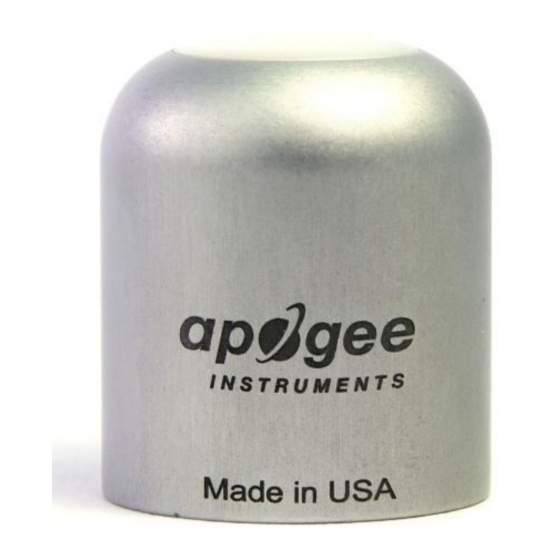Table of Contents
Advertisement
Quick Links
Advertisement
Table of Contents

Summary of Contents for Apogee Instruments SQ-620
-
Page 1: Owner's Manual
OWNER’S MANUAL EXTENDED RANGE PFD SENSOR Models SQ-620 Rev: 28-Oct-2020 APOGEE INSTRUMENTS, INC. | 721 WEST 1800 NORTH, LOGAN, UTAH 84321, USA TEL: (435) 792-4700 | FAX: (435) 787-8268 | WEB: APOGEEINSTRUMENTS.COM Copyright © 2020 Apogee Instruments, Inc. -
Page 2: Table Of Contents
TABLE OF CONTENTS Owner’s Manual ....................................1 Certificate of Compliance ................................. 3 Introduction ..................................... 4 Sensor Models ..................................5 Specifications ................................... 6 Deployment and Installation ..............................8 Cable Connectors ..................................9 Operation and Measurement ..............................9 Maintenance and Recalibration ............................. 12 Troubleshooting and Customer Support .......................... -
Page 3: Certificate Of Compliance
RoHS 3 compliant using exemption 6c. Further note that Apogee Instruments does not specifically run any analysis on our raw materials or end products for the presence of these substances, but rely on the information provided to us by our material suppliers. -
Page 4: Introduction
This means this particular sensor should only be used for photon flux density measurements under LEDs. Apogee Instruments SQ-600 series Extended Range PFD Sensors consist of a cast acrylic diffuser (filter), photodiode, and signal processing circuitry mounted in an anodized aluminum housing. A cable to connect the sensor to a measurement device is also included. -
Page 5: Sensor Models
SENSOR MODELS This manual covers the unamplified model SQ-620 Extended Range PFD Sensor (in bold below). Additional models are covered in their respective manuals. Model Signal SQ-620 Self-powered SQ-622 0-2.5 V SQ-624 4-20 mA SQ-625 0-5 V SQ-626 SQ-627 SDI-12... -
Page 6: Specifications
4 years against defects in materials and workmanship Calibration Traceability Apogee Instruments SQ-600 series PFD sensors are calibrated through side-by-side comparison to the mean of four transfer standard PFD sensors under a reference lamp. The transfer standard PFD sensors are recalibrated with a... - Page 7 Spectral Response Mean spectral response measurements of six replicate Apogee SQ-600 series Extended Range PFD Sensors. Spectral response measurements were made at 10 nm increments across a wavelength range of 300 to 1100 nm in a monochromator with an attached electric light source. Measured spectral data from each PFD sensor were normalized by the measured spectral response of the monochromator/electric...
-
Page 8: Deployment And Installation
An Apogee Instruments model AL-100 leveling plate is recommended for this purpose. To facilitate mounting on a cross arm, an Apogee Instruments model AM- 110 mounting bracket is recommended. -
Page 9: Cable Connectors
CABLE CONNECTORS Apogee sensors offer cable connectors to simplify the process of removing sensors from weather stations for calibration (the entire cable does not have to be removed from the station and shipped with the sensor). The ruggedized M8 connectors are rated IP68, made of corrosion-resistant marine-grade stainless-steel, and designed for extended use in harsh environmental conditions. -
Page 10: Operation And Measurement
In order to maximize the measurement resolution and signal-to-noise ratio, the signal input range of the measurement device should closely match the output range of the PFD sensor. Wiring for SQ-620 White: Positive (signal from sensor) Black: Negative (signal from sensor) - Page 11 Sensor Calibration Apogee SQ-620 Extended Range PFD Sensors have standard calibration factors of exactly: 20 µmol m per mV Multiply the calibration factor by the measured mV signal to convert sensor output to photon flux density in units of µmol m Calibration Factor (20 µmol m...
-
Page 12: Maintenance And Recalibration
3. Salt deposit accumulation from evaporation of sea spray or sprinkler irrigation water. Apogee Instruments upward-looking sensors have a domed diffuser and housing for improved self-cleaning from rainfall, but active cleaning may be necessary. Dust or organic deposits are best removed using water, or window cleaner, and a soft cloth or cotton swab. -
Page 13: Troubleshooting And Customer Support
TROUBLESHOOTING AND CUSTOMER SUPPORT Independent Verification of Functionality Apogee SQ-620 Extended Range PFD Sensors are self-powered devices and output an analog signal proportional to incident photon flux density for the 340-1040 nm wavelength range. A quick and easy check of sensor functionality can be determined using a voltmeter with millivolt resolution. -
Page 14: Return And Warranty Policy
RETURN AND WARRANTY POLICY RETURN POLICY Apogee Instruments will accept returns within 30 days of purchase as long as the product is in new condition (to be determined by Apogee). Returns are subject to a 10 % restocking fee. WARRANTY POLICY... - Page 15 84321, USA 5. Upon receipt, Apogee Instruments will determine the cause of failure. If the product is found to be defective in terms of operation to the published specifications due to a failure of product materials or craftsmanship, Apogee Instruments will repair or replace the items free of charge.

















Need help?
Do you have a question about the SQ-620 and is the answer not in the manual?
Questions and answers